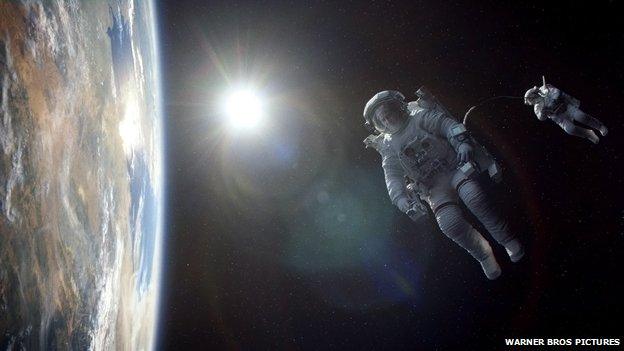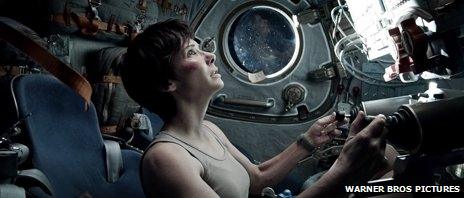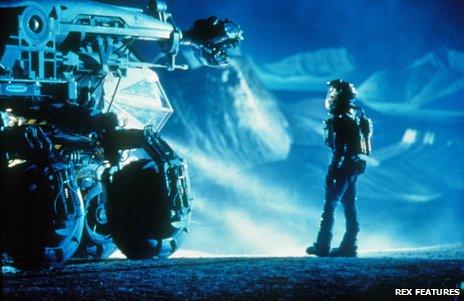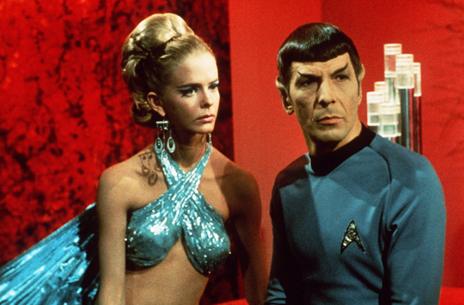Can science fiction ever get the science right?
- Published

New film Gravity promises to rekindle the debate over how "hard" - or accurate - science fiction should be. Should film-makers adhere to basic scientific principles, or should audiences just feel the magic instead, asks Peter Ray Allison.
The relationship between science and science fiction has always been tempestuous.
Gravity focuses on two astronauts stranded in space after the destruction of their space shuttle. Since Gravity's US release (it comes to the UK in November) many critics have praised the film for its scientific accuracy.
But noted astrophysicist Dr Neil deGrasse Tyson, director of the Hayden Planetarium at the American Museum of Natural History in New York, had several issues with the accuracy of Gravity's portrayal of space.
Through a series of posts on Twitter, Tyson - who later emphasised that he "enjoyed the film very much" - highlighted various errors.

He noted the Hubble space telescope (orbiting at 350 miles above sea level), the International Space Station (at 250 miles), and a Chinese space station could never be in line of sight of one another. On top of that, most satellites orbit west to east, yet in the film the satellite debris was seen drifting east to west.
Tyson also noted how Sandra Bullock's hair did not float freely as it would in zero-gravity. This is arguably not so much an error in physics, but a reflection of the limitations of cinematic technology to accurately portray actors in zero-gravity. That is, of course, without sending them into space for the duration of the film.

Sandra Bullock's hair: the subject of scientific debate
There has always been a drive for scientific accuracy within science fiction, especially within the "hard science fiction" literary sub-genre. But sci-fi, especially in film, tends to have a more flamboyant approach, where realism is often dispensed with in favour of visual flair.
The Michael Bay film Armageddon is known for its woeful number of inaccuracies, from the space shuttles separating their rocket boosters and fuel tanks in close proximity to each other (risking a collision) and to objects falling on to the asteroid under a gravitational pull seemingly as strong as the Earth's. More than one interested observer tried to work out how big the bomb, external would have to be to blow up an asteroid in the way demanded in the movie. Answer: Very big indeed.
Nasa is reported to have even used Armageddon as part of a test within their training programme, asking candidates to identify all the scientific impossibilities within the film.

A scene from Armageddon shows earth-level gravity on an asteroid's surface
Despite the presence of physicist Prof Brian Cox as a scientific adviser on Danny Boyle's Sunshine, artistic licence seeped in. There's a communications "dead-zone" around the Sun - not something easily explicable using real world rules.
Despite claims to the contrary, Red Planet was riddled with scientific implausibilities, from the compatibility between modern equipment and 30-year old Russian technology (imagine attempting to connect a modern PC with a Sinclair Spectrum), to the Martian "nematodes" which had been eating algae that had been sent from earth for the past 30 years. The nematodes should have been worms but looked closer to beetles. And there was no explanation as to how they had evolved to eat non-Martian algae nor what they had eaten before.
The science across the film was so "creative" that Nasa refused to act as scientific adviser on the film, external.
But perhaps the biggest example of scientific licence occurs in a plethora of space-based dramas.
"The most commonly lauded example of 'bad science', intentionally placed into science fiction, is that of sound," says Ed Trollope, spacecraft operations engineer at technology firm Telespazio VEGA Deutschland. "Because space is a vacuum, there is no sound, which means all those explosions and engine noises shouldn't be there."
There's a simple cinematic reason for having the sound of an explosion when a spacecraft blows up - it feels right to the viewer. But other conventions are more difficult for scientists to accept.
"My pet peeve is inertia," says Trollope. "There are many good reasons for keeping your engines on in space, but 'maintaining speed' is not one of them. If you turn your engines off, you don't stop."
Some do it slightly better than others. "I'd prefer not to single out a single film/book/series for this particular error, because it's so common - but I will laud the old television show Babylon 5, for doing a wonderful job of representing the mechanics of spaceflight inertia so nicely," explains Trollope.
2001: A Space Odyssey's silent scenes of space craft, with their rotating Stanford torus design, were closer than many later examples to the reality of travelling in space.
"A classic case of scientific inaccuracy was the first edition of Ringworld by Larry Niven, a novel which won both the Hugo and Nebula awards in 1971," suggests science fiction author Charles Stross. "The author inadvertently set up a series of scenes which implied that the Earth spun on its axis in the wrong direction." Niven fixed it in the second printing.
The Duncan Jones film Moon was lauded for a reasonably accurate portrayal of what lunar mining for Helium-3 could look like in the future. Helium-3 is rare on Earth but less rare on the Moon, and using an automated method with a human overseer might be possible. But the economics behind the mining is not explained.

Jodie Foster in Contact (1997)
The alien signal in Contact is a prime example of what Seti (Search for Extra Terrestrial Intelligence) is looking for. This is perhaps not surprising as Contact was written by astronomer Carl Sagan. The use of mathematics in the transmission of the message seems reasonable and the time lag in the sending and receiving of the signal is also accurately represented in the film.
Science fiction is not just expected to accurately portray science but also to anticipate future developments.
"Science fiction hits some predictive targets," says science fiction author Neal Asher, "but rather in the way that a clip fired from an assault rifle will hit some of the enemy hidden in the jungle, but mostly hits trees and leaves."
"One of the past criticisms of science fiction has been that it's all 'zap-guns and rocket ships'," suggests Asher. "Now the science fiction writer can smugly point out the LaWs - the US navy laser system - knocking down drones, and then wax lyrical about the X Prize, Virgin Galactic and Elon Musk's SpaceX."

Leonard Nimoy as Spock (right) in Star Trek
Richard Blott, principal consultant at Space Enterprise Partnerships, recalls an early episode of Star Trek ("Spock's Brain", 1968) where the latest space ship is described as having an "ion drive".
"Nowadays most new communications satellites have ion engines and they have powered missions to Vesta and Ceres," says Blott.
"In the end," Asher concludes, "science fiction is not there to make accurate predictions about the future, it is there to entertain and stimulate the imagination. There is absolutely no doubt that many of the imaginations it stimulates belong to scientists. To some extent it drives and directs science."
Follow @BBCNewsMagazine, external on Twitter and on Facebook, external